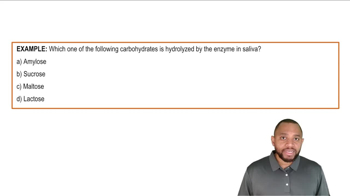Melezitose, a carbohydrate secreted by insects, has the following Haworth structure:
a. Is melezitose a mono-, di-, or trisaccharide?
 Verified step by step guidance
Verified step by step guidance Verified video answer for a similar problem:
Verified video answer for a similar problem:



 1:24m
1:24mMaster Polysaccharides Example 1 with a bite sized video explanation from Jules
Start learning